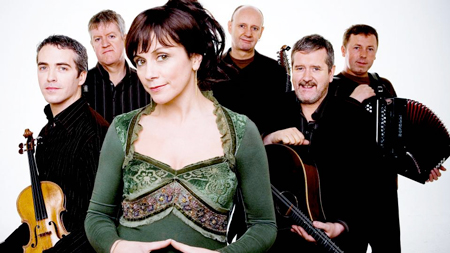by Nicholas Jones

Despite the whimsical name of the band, there were no whirling bodies on the stage of Gartner Auditorium. But the music certainly was high on rotational momentum, the fast dances flying in the hands of these long-time masters of traditional Irish tunes. And by the end of the concert, there was plenty of audience participation, including a few fleet-footed dancers in the aisles.
Dervish’s musical home — and the actual home of several of the band members — is County Sligo, on the northwest coast of Ireland (also home to the poet Yeats, and the setting for the haunting 2014 film Calvary). In keeping with Sligo style, Dervish pumps its tunes with a driving rhythm that is both insistent and flexible. The jigs and reels sparkle with a clear, foot-tapping beat; and yet there are scads of other fascinating poly-rhythms buzzing around what seems at first to be a simple dance tune.
Much of Dervish’s metrical sophistication comes from the remarkable musicianship of flutist Liam Kelly, who plays both fast and smart, investing the repetitive arpeggios of Irish dance music with an infinite variety of accent and expression. His virtuoso flute work is complemented by his mellower but equally gripping work on the whistle.
Cathy Jordan is the long-term lead vocalist for Dervish, and is clearly the musical center of the group. Her singing wove a cloak of deep humanity around the ballads that alternated with instrumental numbers in the program. Jordan demonstrates a thrilling blend of accuracy and abandon. She sings every note out of the box, constantly moving around and about it with slides and ornaments and nudges. Perfectly in tune, clear-voiced, and disciplined, her singing is nonetheless tinged with a nearly raw fervor. In instrumental numbers, Jordan contributed some complex percussion on the bones and the bodhrán.
Grounding the beat were two expert rhythm players. Michael Holmes plays the Irish bouzouki, an offshoot of the Mediterranean member of the guitar family (who knew the instrument had migrated north?). Holmes, a veteran of the band’s nearly three decades of touring and recording, flanked the band on one end of its stage arc, matched on the other end by the excellent mandolinist Brian McDonagh. Accordionist Shane Mitchell, another long-time member of the band, heightened the rhythmic sophistication of the band, as well as contributing some stunning melody work on the squeezebox.
Dervish’s regular fiddle player, we learned, just became a new father back in Ireland and could not make the strenuous three-week US tour that the band launched with this concert. In his place was Kevin Burke, a well-known fiddler based in Portland, Oregon. In some of the numbers, Burke seemed a little tentative, perhaps still finding his way into the ensemble, but he came into his own with a lovely solo number after intermission.
Jordan introduced every tune from the stage with a warm immediacy and a wealth of good Irish anecdotes and jokes (one pointedly noting the marital difficulties caused by a husband with “small hands”).
Dervish is primarily a traditional band, not drawn to the cross-over collaborations of bands like The Chieftains or (in the Scottish tradition) Battlefield Band. The payoff of staying with the old styles is a depth of musicality that clearly arises from each member’s investment in the tradition. They all seem to live the music, and the music lives when they play it.
Published on ClevelandClassical.com March 15, 2016.
Click here for a printable copy of this article



